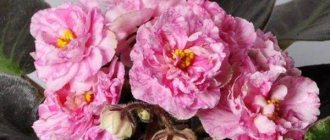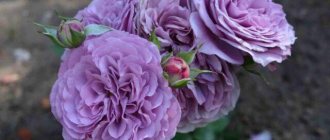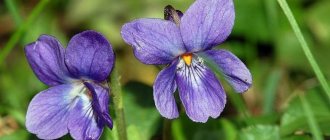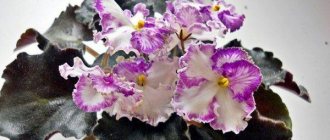Original and delicate violets, having appeared at world flower exhibitions, very quickly attracted everyone's attention.
Flower growers appreciated not only the ability of these tropical beauties to bloom long and luxuriantly, but also their compact dimensions, unpretentious nature and relatively simple methods of caring for plants in indoor collections. Uzambara violets have gained enormous popularity both in the countries of the Old World and on the American continent.
It was American breeders who were the first to begin active development of creating new varieties of violets in order to improve their life characteristics and decorative appearance.
Numerous schools for the selection of Uzambara violets were created .
Many flower growers began to become interested in breeding issues and devote their time and effort to obtaining varietal varieties of Saintpaulia.
One of the masters of American violet selection is Pat Hancock from Middletown, Ohio.
She has created dozens of varieties that successfully grow in the collections of flower growers around the world and have repeatedly become prize winners at various exhibitions.
A distinctive feature of P. Hancock’s selection line with the prefix “Buckeye” is the fact that the master works only with variegated violets , creating varieties with rosettes of surprisingly symmetrical outlines.
The signature prefix "Buckeye" comes from the name of an American tree called deer's eye because of the appearance of its nuts. In Russia this tree is called horse chestnut.
Violet Buckeye Lavender Mist
Description
The Buckeye Lavender Mist violet, a photo and description of which is presented in this section, forms a symmetrically developing leaf rosette, which in terms of diameter is of the large standard type.
Slightly elongated leaf petioles form a loose structure of the bush, but the arrangement of the leaf blades in a mosaic pattern and their variegated coloring create a magnificent exhibition rosette.
The leaf plates of considerable size have a quilted structure, a light venation pattern, a wavy-jagged edge and a variegated border color with a pinkish-beige color against a dark shade of green.
Violets bloom in bouquet type with the formation of large corollas of semi-double fullness.
The petals are colored with shades of lavender of varying intensities with stronger shading on the upper lobes and along the edges, turning into a greenish fringe. Dark lavender specks are scattered in a chaotic manner throughout the bud.
The volume of the corolla increases due to the waviness of its petals.
Features of maintenance and care
Varietal violet is suitable as the first specimen for the collections of flower growers with any experience:
- grows easily and quickly;
- independently forms a beautiful rosette;
- not capricious;
- blooms luxuriantly and for a long time.
Caring for violets has several nuances characteristic of variegated specimens:
- loves cool conditions for better manifestation of leaf variegation;
- requires careful monitoring when feeding - overfeeding with nitrogen can reduce the brightness and width of the edges of the leaf blades.
Reviews
Vera Vasilievna. “Saintpaulia ‘Buckeye Lavender Mist’ captivated me with its lilac-colored color with transitions of tones, with fancy spots and a green edge. And all this splendor is against the backdrop of colorful foliage! Beauty!"
Svetlana Nikolaevna. “The Buckeye Lavender Mist violet has been with me for two years. I took it from a leaf cutting at an exhibition. All this time, the bush delighted me with its even shape and unusual rosette color. The buds only came out about a year and a half later, probably because he didn’t like something in the room. But the flowering did not disappoint expectations - exactly according to the varietal description.”
Violet Buckeye Scrumptious
Description
Saintpaulia is classified as a large standard due to the fact that it forms a leveled rosette of significant diameter. The flat configuration of the bush variety has a dense filling, mosaic distribution of leaf blades and spectacular coloring.
The leaves are distinguished by their rounded shape, medium dimensions, significantly pressed veins of a salad shade and finely serrated edges.
The coloring of the leaf blades combines a background of summer greenery with cream contours in the form of a rim, strokes and specks, the volume of which depends on the microclimate of the room.
The violet blooms in a cap type , forms a huge number of buds of considerable size and blooms with terry fullness. The color of the flowers is distinguished by a blue tone with lilac tints; each petal of the corolla is outlined along a corrugated border with a transitional white-green outline.
NOTABLE! The variety sometimes goes into the sport of light colors and only slight hints of a green border on the petals.
Features of maintenance and care
The variety has not found wide distribution in flower growers’ collections , although it is not inferior to other varieties of the “Bakai” line in its positive characteristics:
- not picky;
- does not require significant lighting;
- blooms easily and luxuriantly.
Violet has a minor drawback : long exposure to light helps to reduce the length of peduncles, due to which the buds are forced to bloom among the leaves or right under them. Light level control is required.
To preserve the decorative appearance of the rosette, it is necessary to keep the violet in cool conditions and control the percentage of nitrogen in fertilizers:
- the lack of this element provokes the disappearance of chlorophyll and almost complete coloring of the leaf in a cream tone;
- excess leads to loss of variegated color.
Reviews
Sonya. “I love the Buckeye Scrumptious variety! I saw it quite by accident at a neighbor’s place; I had never even heard of it before. Everything is just how I like it - a wonderful bluish-lilac color, dusty leaves, waviness of the petals without fanaticism! I’m writing to my wishlist!”
Konstantin Ilyich. “I would like to share an observation about the Saintpaulia variety “Buckeye Scrumptious”: for several seasons, my favorite almost loses the light patterned leaves in the summer heat, and in winter it again acquires all the varietal characteristics. I realized that violets do better in cool conditions.”
Features of choosing a variety and type
Violets have long been the favorites of many gardeners. This flower can be very diverse in appearance. There are unusual hybrid varieties, the care of which does not require much effort, industrial varieties, mini violets, and large collectible species. Saintpaulia was first discovered in the mountains of Africa. And in natural conditions, violet is distinguished by a variety of colors.
New varieties of violets continue to appear thanks to breeding. When choosing a particular variety or type of violet, you need to consider the following nuances:
- If the gardener is a beginner, then the choice should fall on the species that will be easier to care for. Usually these are miniature ampelous violets. Large collectible flowers will require some skill.
- If you are planning a collection of violets, it is advisable to choose those species and varieties that are similar in care, so as not to waste time and effort on different watering, replanting and creating certain conditions.
- When choosing hybrid, fantasy violets, you need to clarify the features of their reproduction. Many hybrid varieties do not transmit their traits when propagated, which means that it will not be easy to breed such flowers.
- If the choice fell on fantasy violet varieties, you need to remember that their petals can change color depending on the conditions of the flower: temperature, humidity, lighting.
The violet is considered a delicate flower for a reason. She loves care and concern. It is believed that the violet senses energy and blooms well only where love and harmony reign. Saintpaulia does not require unusual care, but it is easy to destroy if you do not follow simple rules.
The violet will bloom magnificently and beautifully only if there is enough light for it. She loves diffused light, but not direct sunlight, which will damage the delicate petals. Like any plant, Saintpaulia loves water and needs it. Watering must be adjusted depending on the ambient temperature.
The violet dies both in the absence of moisture and in its excess.
It is not advisable to place a delicate violet next to large indoor flowers, palm trees, and cacti. They often harbor pests and insects that can harm Saintpaulia. But geranium, which usually repels insects, would be a good neighbor for it. When planting or replanting, it is advisable to purchase small pots, since Saintpaulia will begin to bloom only when the rhizome completely fills it.
Violet Buckeye Cherry Freckles
Description
Saintpaulia forms a pretty leaf rosette with symmetrical contours according to the standard type . The bush is always distinguished by an even, rounded configuration and sufficient fullness.
The leaf blades have an oval-elongated shape, light vein graphics, finely rounded serration of the lateral contours and variegated coloring: a combination of the main tone of dark green with pinkish-cream edges.
A distinctive feature of the variety is the reddish tint of the underside of the leaf.
Flowering occurs in a cap type with the formation of many medium-sized buds. Violet corollas are stars of semi-double fullness with smooth, slightly wavy petals.
The color is distinguished by a combination of pink with pearlescent reflections of a color scheme with cranberry-wine fantasy specks and the same tonality with an elegant outline of the contours of the petals.
NOTABLE! Violet can produce burgundy-colored sports with fantasy colors barely noticeable against this background.
Features of maintenance and care
The variety is quite simple to maintain , spectacular for collections, with long-blooming, brightly colored corollas.
If you follow the classic regimes for caring for violets, as well as focusing on the peculiarities of caring for variegated leaves, even novice gardeners can easily grow this variety of Saintpaulia on their windowsills.
ATTENTION! Like all variegated varieties, the variety requires maintenance in cool conditions. This helps preserve the decorative variegated color of the leaf rosette, and also guarantees longer flowering of the blossoming corollas.
Reviews
Cornelia Vyacheslavovna. “I purchased the violet “Buckeye Cherry Freckles” at the exhibition - a charming variety, translated as “cherry freckles.” And indeed, a very appropriate name. The entire pinkish-pearl flower is splashed with small specks of cranberry juice. Satisfied with the purchase."
Timofey Mikhailovich. “I have been collecting a collection of various Buckeye varieties for a long time, and Saintpaulia “Buckeye Cherry Freckles” occupies a privileged position for me. Her specks are exactly like my granddaughter’s freckles.”
Caring for a plant at home
Caring for Saintpaulia always consists of a complex; if you do not follow and violate one of the points of caring for a violet, then it will feel discomfort , and you will not get beautiful flowering.
Conditions for keeping the variety
The Zosya variety loves a lot of light, is afraid of drafts, and also does not like sudden temperature changes . In summer, you need to place the violet not on the southern windows, avoid direct sunlight.
Due to exposure to bright sunlight, especially for those who live in central Russia, the flowers on the peduncles quickly fade , and the plant itself, if direct sunlight hits the delicate leaves, can get burns.
Proper watering and fertilizing
For proper watering for Saintpaulia “Zosya”, you need to take into account both the time of year and the air humidity in the room. When the room is hot and dry, watering will be needed more often . But in the summer, especially when the temperature is rapidly approaching 30 degrees, oddly enough, the violet begins to consume less water.
Therefore, you need to pay attention to the soil in the pot . As the water evaporates from the pot it becomes lighter. If the soil has dried out by about one centimeter, then you need to water the plant.
For irrigation use soft, preferably boiled, settled water . It should be room temperature, or better yet, a few degrees higher.
Saintpaulia needs to be watered on time.
They begin to feed the violet when it has been growing for six months without replanting . Fertilize the violet every two weeks. Using complex products for violets for this purpose. When the temperature in the room reaches 28 °C and above, they stop feeding the violet. It is better to feed violets with anti-stress drugs, such as:
- Zircon;
- And Epin.
Important! Violet babies are not fed. Only one month after separation from the mother leaf, the baby can be fed with fertilizer containing nitrogen. And after three months, fertilizing should contain more phosphorus than nitrogen.
Lighting and air temperature, what is better for the plant: heat or coolness?
Of course, every violet lover has his own ideal place:
- For some, these are illuminated shelves;
- For others, a wide window sill with shelves;
- And some people have enough light on a bright veranda.
This variety does not like heat; a temperature of at least 18°C is best .
For year-round flowering, sufficient lighting is important; daylight hours should be 10-12 hours .
How does air humidity affect a plant?
For violets, low humidity is the enemy . The humidity in the room should be maintained at 50-60%. Humidify the air by purchasing a special humidifier. Or place containers with water and pebbles or moistened moss nearby. In winter, hang wet towels on the radiators.
Important! Remember, violet is a flower that cannot be sprayed.
This violet loves moist air.
What kind of soil does the plant prefer when growing at home?
One of the conditions for successfully growing violets is a properly selected substrate. The substrate contains different components :
- High peat,
- river sand,
- coconut substrate,
- Perlite,
- Chernozem,
- Sphagnum moss,
- Humus,
- Charcoal.
Violets like light and loose soil , which allows air to pass well to the roots and retains moisture.
It is better not to experiment, but to buy special soil for Saintpaulia in the store. Ordinary garden soil is not suitable for growing violets.
to add baking powder to the purchased soil , such as:
- Perlite;
- Sphagnum moss;
- Or foam balls and others.
Without such an additive, the soil will quickly compact and dry out poorly.
Plant pruning and hygiene
When a plant from a baby grows to the size of a starter, stepsons form in the axils of the leaves . These babies growing between the leaves thicken the rosette and spoil not only the appearance, distorting the shape, but the plant also spends additional energy and nutrients for the growth of such stepsons.
If you do not need additional cuttings of this variety, then you should remove the resulting stepsons in a timely manner, preventing them from increasing in size.
The variety needs to be trimmed dry and wet leaves.
Violet pruning is carried out in the following cases :
- Remove excess leaves;
- Cause stimulation of lush flowering;
- To remove diseased leaves to prevent the disease from spreading to healthy leaves;
- Cutting off the top of an old violet and planting it in a new substrate to rejuvenate it.
Advice! Every 2 years you need to rejuvenate the Saintpaulia or replace it with a young seedling. To do this, the plant’s stem is shortened and the crown is placed in water; when it gives roots, it is planted in new soil. Or you can rejuvenate it in a different way, cutting off the bottom row of leaves, but this will give an insignificant effect, only rejuvenating the violet by a year.
Methods of propagation of the variety
Most often this is done in three ways:
- Leaf cuttings;
- Stepchildren;
- Or flower stalks.
The easiest method of propagation is leaf cuttings . A healthy leaf with a fairly long stalk, it is cut and immersed in soil or water to form roots, and then the leaf with roots is planted in the ground.
Each jar in which the planting was carried out should be equipped with a tag indicating the variety , otherwise, if you hope for chance, you will still forget what kind of violet it grows where. When the baby forms 2-3 pairs of leaves the size of a marigold, it is planted.
But there is no need to rush to plant children whose leaves have not become green enough. Without a mother leaf, they will sit in place for a long time or even die.
Rules for transplantation, plant rejuvenation
To replant Saintpaulia, use plastic or clay pots , the main thing is that the pot is suitable in size and has drainage holes in the bottom, as well as a tray.
Remove the plant from the pot and remove any old soil from the roots. Loose soil will fall off on its own; just shake it off.
It is better to rejuvenate an old violet.
Drainage is poured into the same pot ; you can use expanded clay for these purposes, in a layer of 1–2 cm. Add the prepared substrate and plant the violet in the center, lightly pressing the soil, but not compacting it too much.
Then lightly moisten the soil in the pot. The next watering will be needed after five to six days. During this time, damage to the roots will heal.
Features of flowering varieties in hot and cool conditions
The Zosya variety, like other violets, does not tolerate heat, and for it to bloom it is necessary to ensure a low temperature within 18-23 degrees .
If the temperature is above 28 degrees, the plant often begins to dry out or drop flower stalks and unopened buds.
Therefore, in summer, the violet needs to be moved to a cooler room and provided with frequent ventilation; an air conditioner or fan can be used to cool the air.
But it is worth making sure that cold air flows do not enter and are not directed at the Saintpaulia.
Is it possible to achieve cap flowering from a variety?
Cap flowering can be achieved only by observing all the conditions for caring for the plant. The following factors can interfere with lush bouquet flowering :
- Side rosettes – their appearance is a sign of plant aging and must be removed. This procedure allows you to keep the plant young longer and promotes lush flowering;
- Pests – can cause complete or partial failure of flowering. A plant affected and weakened by pests will not show vigorous flowering;
Pests need to be gotten rid of quickly. - Watering - the watering regime is an important factor for full development and, of course, important when planting buds. Violet "Zosya" does not like a dry earthen clod, but excessive watering will lead to rotting of the roots and disease of the plant. Violations of the irrigation system will lead to the inability of Saintpaulia to bloom;
- Wrong concentration and choice of fertilizers - for violets you need to dilute fertilizers with a weaker concentration 2-3 times than for other indoor plants. For Saintpaulia to bloom, more phosphorus fertilizers and less nitrogen fertilizers are needed.
Duration of flowering bud
Violet “Zosya” by Tatiana Dadoyan blooms profusely and for a long time . This terry variety has slow bud opening, and the flowers themselves are bright and retain the color of the buds for a long time.
By following all the recommendations, you will grow healthy and strong Saintpaulia , and it will thank you with magnificent flowering several times a year.
If your window sills are lined with beautiful violets of different varieties, then among them there should definitely be a place for the “Zosya” variety by Tatyana Dadoyan.
Advice! Saintpaulias like consistency, so if you have violets under artificial lighting, you need to set a timer so that the light turns on and off at the same time.
Violet Buckeye Butterflies
Description
The violet forms a symmetrical rosette of the standard type , but has a certain predisposition to elongation of leaf petioles, which contributes to loosening the fullness of the rosette and the transparency of its outlines.
Small-caliber violet leaves are distinguished by their color in the tonality of dark green with an elegant frame of pinkish-beige color along the very edge of the leaf plate. The oval configuration of the leaf with finely toothed notches ends at the tip with a distinct point. The lower leaves may be tucked into the flowerpot.
Violet blooms with large terry-type corollas , characterized by transitions of lavender color in varying degrees of intensity to a dark shade along the edge of the petals. , fall on the leaves of the rosette as they bloom
The variety blooms for a long time, the flowers do not lose their freshness.
Features of maintenance and care
With proper care, the Buckeye Butterflies variety
But the process of forming a rosette requires additional effort (using a corset, controlling lighting), since violet likes to pull out leaf petioles, loosen the outline or curl the leaves down.
CAREFULLY! For the correct formation of buds and the straight arrangement of peduncles during flowering in the Buckeye Butterflies variety, it is necessary to take care of sufficient lighting of the specimens preparing for flowering. Otherwise, violet flowers will fall on the leaves, which will significantly reduce the decorative value of the plant.
Reviews
Natalya Illarionovna. “I would like to give advice to beginning violet lovers. If you like the Buckeye Butterflies variety, buy a plant that is already flowering or be patient to form a rosette of leaves. It will take a lot of time, a corset for the socket, control of the light level and a cool room to get a decent result.”
Sergey Leonidovich. “I never had Buckeye varieties in my collection, but Saintpaulia “Buckeye Butterflies” captured my imagination: against the backdrop of a dark lawn with a pinkish pattern, I saw spectacular butterflies. I bought a leaf cutting, struggled with the rosette, and now I’m struggling with the flower stalks. But beauty requires sacrifice."
Violet Buckeye Legal Tender
Description
Saintpaulia forms a standard type rosette with an amazingly aligned, filled configuration, representing a semi-ball of beautifully arranged and slightly downward-curving leaves.
Shiny leaf plates of elongated contours with a sharp nose at the end, a clear venation pattern and small inversions of the lateral serrated edges are characterized by a shade of dark green with a white openwork along the contour.
Above the leaf rosette blooms a lush cap of magnificent snow-white corollas of a single or semi-double type, wrapped in a thick fringe in the shade of delicate lilac with a green border. Subtle drops of fantasy are scattered across all the petals.
Lush and long flowering.
Features of maintenance and care
The variety belongs to the group of problem-free Saintpaulias , which can be grown by both experienced flower growers and those new to violet cultivation.
You just need to remember the nuances of keeping variegated violets:
- cool room;
- control over the application of nitrogen fertilizers;
- not too bright light.
If these conditions are met, the variety will delight you with its decorative variegated rosette and very long flowering.
Reviews
Liliya Lvovna. “I love Saintpaulia 'Buckeye Legal Tender.' She has been living with me for several years and blooms with majestic white caps. Each flower is covered in a foam of thick fringe; delicate lilac specks and lilac-green frames run through all the flowers. Sophistication! Magnificence!
Nikolay Ivanovich. “I’ve never grown variegated leaves, so in the case of the violet variety “Buckeye Legal Tender” I made unforgivable mistakes. He paid with the deprivation of the beautiful variegated rosette. Now I know to watch the temperature and light and not add too much nitrogen. I gained experience and corrected mistakes.”
Violet Buckeye Sarsparilla
Description
The powerful rosette of Saintpaulia is classified according to the large standard type , as it forms a bush of considerable size, aligned in configuration and quite densely filled. It is distinguished by its excellent structure and bright pattern, formed according to the mosaic principle.
The leaf blades of the variety are distinguished by an oval-pointed contour, a lighter shade of the venation pattern, a rounded-notched serration of the edge and a bordering variegation of a cream shade against the background of a summer green color.
The violet forms corollas of medium diameter and terry fullness , painted with a tint of lilac-lavender coloring with a edging of white and greenish ribbons.
Important! Flowering is of the cap type, very abundant and long lasting.
Features of maintenance and care
The variety is not capricious regarding the conditions of detention ; it is a representative of violets with a light character. Even a beginner can grow it in a collection, subject to certain nuances:
- cool microclimate;
- lighting level control;
- careful implementation of the watering regime;
- maintaining the percentage of chemical elements in fertilizers in accordance with the life phases of the plant.
Reviews
Alexander. “I gave my wife a gorgeous Buckeye Sarsparilla violet for her birthday.” It took me a long time to choose, but I liked both the color and the size of the flowers, and now I proudly bear the title of best husband for the beauty of the rosette.”
Zinaida Ivanovna. “Saintpaulia “Buckeye Sarsparilla” is my favorite in my collection. An exquisite rosette, albeit somewhat large in size, beautiful bordering variegation of leaves, long-lasting flowering with spectacular lilac-colored roses. Wonderful variety! "
Reviews
Svetlana. Amazing variety, blooms for a long time. The violet color is rich and so unusual. Its color reminds me of salmon fillet. This variety is my favorite. To prevent fungal diseases, I treat the soil with a solution of Fitosporin once a month and my collection is fine.
Elena. Dadoyan violet varieties are true works of floristic art. I just fell in love with the soft terry violet “Zosya”, it filled the house with bright colors.
Violet Buckeye Cranberry Sparkler
Description
The violet forms a leaf rosette along the upper digital boundary of the type, so it is classified as a large standard . The rosette of the variety always has dense filling, aligned boundaries and a magnificent pattern of tiers due to the mosaic arrangement of variegated leaves.
The rounded leaf blades have a serrated jagged edge, a smooth surface structure, a slight point at the tip and are colored in a shade of dark green with a creamy pink edged frame in the form of ribbons, strokes and specks.
blooms in a cap type , producing medium-sized semi-double corollas with wavy contours of the petals. The coloring is distinguished by raspberry fantasy strokes scattered across the main pink background and a wave of the same shade along the fringe of the petals.
Features of maintenance and care
According to the main maintenance regimes, violet does not differ from other variegated varieties , belonging to the group of specimens with a simple character and easy care. Just don’t forget about the nuances of caring for variegated varieties, and the plant in your collection will feel great.
ADVICE! When equipping a place for additional illumination of violets with fluorescent lamps, the plant should not be placed close to the light source. Too much light can cause the light variegated leaf pattern to diminish or disappear entirely.
Reviews
Tamara Alekseevna. “I would like to warn flower growers who have never worked with variegated violets, but have purchased the Buckeye Cranberry Sparkler variety. In winter lighting, I placed my variegated violet closer to the light, I wanted to do what was best. But gradually my beauty began to lose the light patterns on the leaves until she became completely green. A friend helped out and advised me to move the pot away from the lamp. And the drawing returned, slowly, but in full.”
Olga Nikolaevna. “Saintpaulia ‘Buckeye Cranberry Sparkler’ is my first experience with variegated varieties. It has been growing for me for many years, it pleases me with its patterned greenery and abundant flowering. The main thing is that violet always has a decorative appearance.”
Chimera
Unusual beautiful flowers were called chimera violets because when they are propagated, you can get plants that differ in external characteristics from the mother. Americans were actively involved in the selection of chimeras. At the moment, there are a large number of varieties of this type of violet. The peculiarity of this flower is the fact that this species was not originally bred by breeders. The chimera appeared as a result of mutation.
You can distinguish the chimera from other types of violets thanks to the light stripe that runs down the center of each bright petal.
The shades of the buds may differ depending on the type: blue, purple, light blue, crimson. It is quite rare to find a chimera violet that also has a stripe on its leaves.
This type of violet requires certain care:
- You need to water the flower with water at room temperature or a little warmer. Chimera does not like cold water. It causes brown spots to appear on the flower.
- Chimeras are small violets. When replanting them, you should not choose large pots. The diameter of the pot should not exceed 12 cm for an adult plant and 6 cm for a seedling. You can choose plastic or ceramics.
- Chimeras are quite resilient and bloom for a long time. They do not need frequent feeding. Some gardeners prefer not to feed plants at all. However, if there are signs of soil depletion, you need to use liquid or granular fertilizers specifically for violets.
- Chimera, like any violet, does not like it when the water in the pot stagnates. To avoid waterlogging, drainage made of polystyrene foam or expanded clay is placed at the bottom of the pot.
- There should be enough light. Chimera feels good on an eastern windowsill. If the lighting in the room is poor, you need to create it artificially. Without enough light, the violet will not bloom.
- It is worth remembering that the chimera is considered a capricious flower, so it will be difficult for a beginner to immediately achieve lush flowering.
At the moment, it has not been possible to purposefully obtain a chimera from a seedling. It can form from any other type of violet completely randomly and it is difficult to predict this process. Since it is difficult to breed chimeras, flower growers buy from specialized stores. When choosing a plant, you need to pay attention to the leaves and examine them carefully for spots and darkening. It is very difficult to cure a diseased violet, especially for beginners.
Violet Buckeye Gift Wrapped
Description
The Buckeye Gift Wrapped violet, the photo of which you can see just above, forms a rosette of quite large diameter, and therefore belongs to the large standard type.
The bush has the symmetrical contour required by the varietal description, and is slightly loosely full due to the elongated leaf cuttings.
The oval-shaped leaf plates are painted in a dark green color with a framing ribbon of pinkish-beige border. The leaves have a glossy texture with a shiny surface and a reddish underside.
The flowering of violets is distinguished by the formation of large pink stars of semi-double or double fullness , which are given volume by the wavy edges of the petals with crimson fantasy frills and small specks throughout the flower.
Features of maintenance and care
The variety can be recommended for breeding in any collections . It is not capricious, blooms beautifully for long periods of time.
The main thing is to follow care regimes specific to variegated varieties:
- temperature regime – cool content;
- illumination – optimal level;
- watering - without fanaticism and drying out;
- fertilizing – control of nitrogen content.
Reviews
Anna Petrovna. “They gave me my first Saintpaulia - the Buckeye Gift Wrapped variety. Such cute roses against a background of dark greenery with a pinkish pattern. I will study literature and create decent conditions for my beauty.”
Anatoly Sevastyanovich. “I am collecting a collection of variegated violets; the “Bakai” group is represented by several specimens. “Buckeye Gift Wrapped” was one of the first varieties I purchased. All violets in this group behave perfectly, grow with standard care, bloom long and luxuriantly.”
Violet Buckeye Cranapple
Description
Saintpaulia, forming a large rosette, is classified according to the large standard type . The violet does not have a leveled contour, it is distinguished by its power, but some scattering of leaves, as well as the loose fullness of the rosette due to long leaf petioles.
The leaves are characterized by the presence of a quilted surface structure, a light venation pattern, a rounded-pointed configuration and round-notched denticles along the entire contour. The leaf plates are painted in a dark green color with a voluminous border of pinkish and beige shades.
Violet blooms are not particularly lush, only a few flowers. The corollas have semi-double fullness, wavy edges of the petals, and a slightly lighter center.
The coloring book features various shades of lavender with fantasy purple sprinkled throughout. The intensity of color may vary from bloom to bloom.
The Buckeye Cranapple variety produces two sports:
- purple with dark tint;
- pinkish-purple with light tint.
In both sports there is no presence of fantasy inclusions.
Features of maintenance and care
The variety is mainly content with standard care regimens for variegated varieties of violets , but there are some nuances.
The violet does not tolerate direct rays of the sun at all - contact is fraught with burns and a decrease in the decorativeness of the bush.
Advice! You can slightly straighten the outline of the rosette using a special corset, and you can try to change the length of the leaf petioles by adjusting the temperature and lighting level.
Reviews
Fedor Petrovich. “I bought a leaf of the Buckeye Cranapple variety and tried to grow a symmetrical, aligned rosette. But I got leaves scattered in different directions on long cuttings and a very large diameter. The variety is suitable for gardeners who do not save space and those who like unruly rosettes. Gave me the violet."
Valentina Yanovna. “I begged a leaf of Saintpaulia “Buckeye Cranapple” from a friend, I really liked the purple fantasy ones. But my violet bloomed sporting a dark shade and completely without specks. I didn’t know that this variety could be a sport. Bad luck."
Violet Buckeye Big Snowstorm
Description
Violet belongs to the large standard type. The rosette is formed within aligned boundaries, the diameter is slightly larger than standard sizes.
The elongated leaf blades are distinguished by the presence of a bright creamy shade of mosaic-type variegation against a background of dark greenery. The leaves have a smooth surface and a rounded-notched serrated edge.
The violet blooms with the formation of a huge number of large buds, opening with snow-white corollas of terry fullness with corrugated contours of the petals. According to the varietal description, white flowers may exhibit a bluish glow.
Photo of Buckeye Big Snowstorm violets.
Features of maintenance and care
Violet is ideal for any collection of experienced gardeners or beginners:
- is not capricious about the conditions of detention;
- develops quickly;
- forms the socket independently;
- The flowering deserves special praise - so many buds are forming and the blooming flowers are so magnificent.
To maintain the decorative appearance of the leaf rosette, when caring for violets, one should not forget about cool conditions, control of the brightness of the lighting and the correct feeding regime , especially nitrogen fertilizers. The rest are standard care rules.
Reviews
Irina Gennadievna. “Saintpaulia 'Buckeye Big Snowstorm' is my favorite violet. Its name could not be more accurate when describing a fully blossomed plant. This is a real “White Blizzard” - the color is snow-white, and the flowers are like snowballs.”
Dmitry Alekseevich. “I recently gave my wife a Buckeye Big Snowstorm violet. I want it to remind us of the wedding and its beautiful bridal bouquet.”
Winter Rose and Darling
The unusual purple violet Winter Rose really resembles a rose with its buds. The flowers are very bright, deep purple with a thin white edge. This flower will become a real decoration of any flower garden. It can be propagated without problems. The children take on all the features of the mother plant.
The good thing about the violet called Darling is that its flowering lasts for a very long time. With proper care, the flower can delight the grower with bright buds almost all year round. The flowers are usually pale pink in color, but lighter milky shades are also found. The buds are not very large, medium in size, but there are quite a lot of them, so Darling blooms magnificently. The intensity of the color largely depends on the ambient temperature. To get lighter shades, you need to put the violet in a cool place.
Caring for Winter Rose and Darling is not much different from standard care for Saintpaulia:
- Violet is a delicate flower that does not like drafts. Both Winter Rose and Darling will begin to get sick in the draft. If it is cold air, the flower can be destroyed. Therefore, it is necessary to choose those window sills where the flowers will be well protected from the movement of both cold and hot air.
- For Winter Rose and Darling, the optimal temperature will be 23-25 degrees. In the cold season, you can give the plant a rest by reducing the room temperature to 18 degrees.
- It is necessary to provide the flower with light, but protect it from direct sunlight. Darling, like the Winter Rose, will report a lack of lighting: its leaves will begin to stretch upward. If there is too much light, the leaves will begin to turn pale.
- These varieties of violets love feeding. They can be fertilized quite often, but choose the fertilizer carefully. The fertilizer should contain enough calcium, potassium, magnesium, and phosphorus. Moreover, all microelements must be balanced. In order not to make a mistake in the proportions, you can buy fertilizer in a specialized store and follow the instructions.
- It is best to water the violet at the same time. The soil should be constantly moistened, but it is necessary to avoid waterlogging and excess moisture, which can cause the roots of the plant to rot.
If you need to quickly propagate a plant, then it is better to choose Darling. It produces a huge number of daughter shoots. They can be planted or simply removed to encourage more luxuriant flowering.











